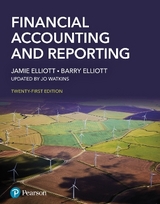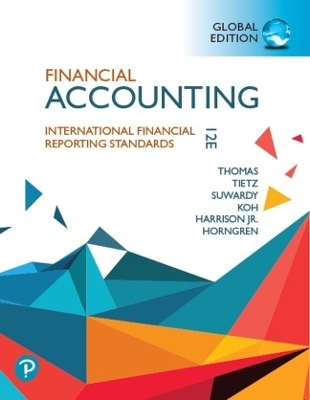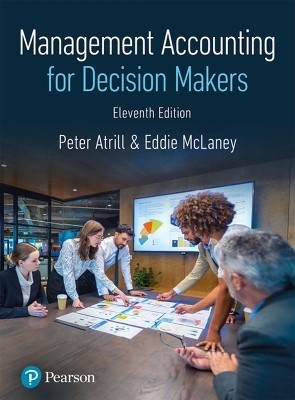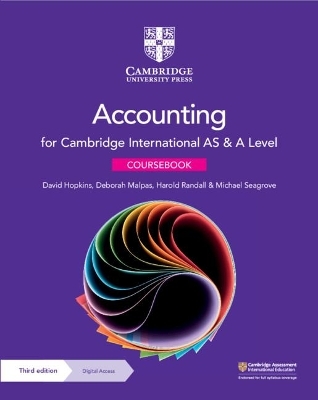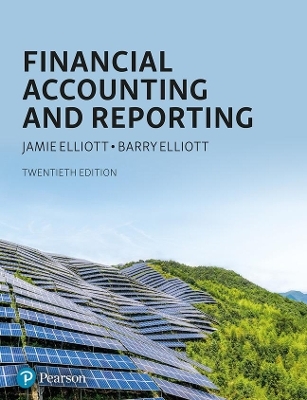
Financial Accounting and Reporting + MyLab Accounting with Pearson eText (Package)
Pearson Education Limited
978-1-292-40909-2 (ISBN)
- Titel erscheint in neuer Auflage
- Artikel merken
This edition provides enhanced coverage of financial statements interpretation according to the IFRS, considering all the risk factors that companies and accountants need to tackle on a daily basis. With this in mind, the book offers an extensive analysis of the topics and risks to support your understanding of the issues both on a commercial and technical level.
Additionally, the latest edition offers further discussion on ethical issues and accountability, ensuring you get the tools and knowledge you need to advance your studies and career in the field.
Key features
Improved flow of topics and revised explanations make the text even easier to follow and understand.
Exercises of varying difficulty include questions from past examination papers of professional accounting bodies.
Updated illustrations, taken from real-world examples of international companies' reports and accounts, demonstrate the application of key principles in practice.
Up-to-date content includes new material on accountability, sustainability, ethical problems, and the future of audit services.
Includes the latest accounting standards, as set out in the IFRS, IAS and the Conceptual Framework for Financial Reporting, as well as a discussion of the proposed IFRS on General Presentation and Disclosure.
Meeting the ethical, judgmental, and technological challenges as an accountant requires thorough academic and professional preparation. This market-leading text provides the foundation necessary to help you develop the technical and critical skills you need to excel later in your career.
For Second Year Financial Accounting modules or modules on Financial Reporting on undergraduate and MBA courses.
Personalise learning with MyLab® Accounting. By combining trusted author content with digital tools and a flexible platform, MyLab Economics personalises the learning experience and improves results for each student.
9781292409092 Financial Accounting and Reporting, 20th edition with MyLab® Accounting
Pack consists of:
9781292399805Financial Accounting and Reporting 20th edition
9781292401034 Financial Accounting and Reporting 20th edition MyLab Accounting
9781292401041 Financial Accounting and Reporting 20th edition Pearson eText
NOTE: Before purchasing, check with your instructor to confirm the correct ISBN. Several versions of the MyLab® platforms exist for each title, and registrations are not transferable. To register for and use MyLab Accounting, you may also need a Course ID, which your instructor will provide.
Used books, rentals, and purchases made outside of Pearson:
If purchasing or renting from companies other than Pearson, the access codes for the MyLab platform may not be included, be incorrect, or previously redeemed. Check with the seller before completing your purchase.
Jamie Elliott is a director who has worked for Deloitte, Huawei, Panasonic, and Mott MacDonald. Prior to his corporate career, he lectured in undergraduate degree programmes and was Assistant Professor in MBA and Executive Education programmes at the London Business School. Barry Elliott has extensive teaching experience in undergraduate, postgraduate, and professional programmes in England, New Zealand, China, Hong Kong, and Singapore. He has worked for Coopers & Lybrand as a Training Manager in London and National Training Manager in Australia. He has extensive experience as an external examiner in higher education at all levels of professional education.
Brief contents: PART 1 INTRODUCTION TO ACCOUNTING ON A CASH FLOW AND ACCRUAL ACCOUNTING BASIS
Accounting and reporting on a cash flow basis
Accounting and reporting on an accrual accounting basis
PART 2 PREPARATION OF INTERNAL AND PUBLISHED FINANCIAL STATEMENTS
Preparation of financial statements of profit or loss and other comprehensive income, changes in equity and financial position
Annual report: additional financial disclosures
Statements of cash flows
Accounting for price-level changes
PART 3 REGULATORY FRAMEWORK – AN ATTEMPT TO ACHIEVE UNIFORMITY
Financial reporting – evolution of global standards
Concepts – evolution of an international conceptual framework
Revenue recognition
PART 4 STATEMENT OF FINANCIAL POSITION – EQUITY, LIABILITY AND ASSET MEASUREMENT AND DISCLOSURE
Share capital, distributable profits and reduction of capital
Liabilities
Financial instruments
Employee benefits
Taxation in company accounts
Property, plant and equipment (PPE)
Leasing
Intangible assets
Inventories
Construction contracts
PART 5 CONSOLIDATED ACCOUNTS
Accounting for groups at the date of acquisition
Preparation of consolidated statements of financial position after the date of acquisition
Preparation of consolidated statements of profit or loss, changes in equity and cash flows
Accounting for associates and joint arrangements
Introduction to accounting for exchange differences
PART 6 INTERPRETATION
Earnings per share
Review of financial ratio analysis
Analysis of published financial statements
PART 7 ACCOUNTABILITY
Corporate governance
Ethical behaviour and implications for accountants
Integrated reporting: sustainability, environmental and social
Index Full contents: PART 1 INTRODUCTION TO ACCOUNTING ON A CASH FLOW AND ACCRUAL ACCOUNTING BASIS
Accounting and reporting on a cash flow basis
1.1 Introduction
1.2 Shareholders
1.3 What skills does an accountant require in respect of external reports?
1.4 Managers
1.5 What skills does an accountant require in respect of internal reports?
1.6 Procedural steps when reporting to internal users
1.7 Agency costs
1.8 Illustration of periodic financial statements prepared under the cash flow concept to disclose realised operating cash flows
1.9 Illustration of preparation of statement of financial position
1.10 Treatment of non-current assets in the cash flow model
1.11 What are the characteristics of these data that make them reliable?
1.12 Reports to external users
1.13 Micro businesses
Summary Review questions Exercises Notes
Accounting and reporting on an accrual accounting basis
2.1 Introduction
2.2 Historical cost convention
2.3 Accrual basis of accounting
2.4 Mechanics of accrual accounting – adjusting cash receipts and payments
2.5 Reformatting the statement of financial position
2.6 Accounting for the sacrifice of non-current assets
2.7 Published statement of cash flows
Summary Review questions Exercises Notes
PART 2 PREPARATION OF INTERNAL AND PUBLISHED FINANCIAL STATEMENTS
Preparation of financial statements of profit or loss and other comprehensive income, changes in equity and financial position
3.1 Introduction
3.2 Preparing an internal statement of profit or loss from a trial balance
3.3 Reorganising the income and expenses into one of the formats required for publication
3.4 Format 1: classification of operating expenses and other income by function
3.5 Format 2: classification of operating expenses according to their nature
3.6 Other information to be presented in the profit or loss section
3.7 Other comprehensive income
3.8 Presentation of non-recurring items and their effect on operating income
3.9 How decision-useful is the statement of profit or loss and other comprehensive income?
3.10 Statement of changes in equity
3.11 The statement of financial position
3.12 The explanatory notes that are part of the financial statements
3.13 Has prescribing the formats meant that identical transactions are reported identically?
3.14 Fair presentation
3.15 What does an investor need in addition to the primary financial statements to make decisions?
3.16 IAS 1 ED General Presentation and Disclosures
Summary Review questions Exercises Notes
Annual report: additional financial disclosures
4.1 Introduction
4.2 IAS 10 Events after the Reporting Period
4.3 IAS 8 Accounting Policies, Changes in Accounting Estimates and Errors
4.4 What do segment reports provide?
4.5 IFRS 8 Operating Segments 80
4.6 Benefits and continuing concerns following the issue of IFRS 8
4.7 Discontinued operations — IFRS 5 Non-current Assets Held for Sale and Discontinued Operations
4.8 Held for sale — IFRS 5 Non-current Assets Held for Sale and Discontinued Operations
4.9 IAS 24 Related Party Disclosures
Summary Review questions Exercises Notes
Statements of cash flows
5.1 Introduction
5.2 Development of statements of cash flows
5.3 Applying IAS 7 (revised) Statement of Cash Flows
5.4 Step approach to preparation of a statement of cash flows — indirect method
5.5 Additional notes required by IAS 7
5.6 Analysing statements of cash flows
5.7 Approach to answering questions with time constraints
5.8 Preparing a statement of cash flows when no statement of income is available
5.9 Critique of cash flow accounting
Summary Review questions Exercises Notes
Accounting for price-level changes
6.1 Introduction
6.2 Review of the problems of historical cost accounting (HCA)
6.3 Inflation accounting
6.4 The concepts in principle
6.5 The four models illustrated for a company with cash purchases and sales
6.6 Critique of each model
6.7 Operating capital maintenance – a comprehensive example
6.8 Critique of CCA statements
6.9 Measurement bases
6.10 The IASB position where there is hyperinflation
6.11 Future developments
Summary Review questions Exercises Bibliography Notes
PART 3 REGULATORY FRAMEWORK – AN ATTEMPT TO ACHIEVE UNIFORMITY
Financial reporting — evolution of global standards
7.1 Introduction
7.2 Why do we need financial reporting standards?
7.3 Why do we need standards to be mandatory?
7.4 Arguments in support of standards
7.5 Arguments against standards
7.6 The Financial Reporting Council (FRC) as a regulatory body
7.7 The International Accounting Standards Board
7.8 Standard setting and enforcement in the European Union (EU)
7.9 Standard setting and enforcement in the US
7.10 Advantages and disadvantages of global standards for publicly accountable entities
7.11 How do reporting requirements differ for non-publicly accountable entities?
7.12 IFRS for SMEs
7.13 Why have there been differences in financial reporting?
7.14 Move towards a conceptual framework
Summary Review questions Exercises Notes
Concepts — evolution of an international conceptual framework
8.1 Introduction
8.2 Different countries meant different financial statements
8.3 Historical overview of the evolution of financial accounting theory
8.4 Developing the Framework for the Preparation and Presentation of Financial Statements
8.5 Conceptual Framework for Financial Reporting 2018
8.6 Current developments – concept of materiality
Summary and evaluation of position to date Review questions Exercises
Revenue recognition
9.1 Introduction
9.2 The issues involved in developing the new standard
9.3 IFRS 15 Revenue from Contracts with Customers
9.4 Five-step process to identify the amount and timing of revenue
9.5 Disclosures
Summary Review questions Exercises Notes
PART 4 STATEMENT OF FINANCIAL POSITION — EQUITY, LIABILITY AND ASSET MEASUREMENT AND DISCLOSURE
Share capital, distributable profits and reduction of capital
10.1 Introduction
10.2 Common themes
10.3 Total owners' equity: an overview
10.4 Total shareholders' funds: more detailed explanation
10.5 Accounting entries on issue of shares
10.6 Creditor protection: capital maintenance concept
10.7 Creditor protection: why capital maintenance rules are necessary
10.8 Creditor protection: how to quantify the amounts available to meet creditors’ claims
10.9 Issued share capital: minimum share capital
10.10 Distributable profits: general considerations
10.11 Distributable profits: how to arrive at the amount using relevant accounts
10.12 When may capital be reduced?
10.13 Writing off part of capital which has already been lost and is not represented by assets
10.14 Repayment of part of paid-in capital to shareholders or cancellation of unpaid share capital
10.15 Purchase of own shares
Summary Review questions Exercises Notes
Liabilities
11.1 Introduction
11.2 Provisions — a decision tree approach to their impact on the statement of financial position
11.3 Treatment of provisions
11.4 The general principles that IAS 37 applies to the recognition of a provision
11.5 Management approach to measuring the amount of a provision
11.6 Application of criteria illustrated
11.7 Provisions for specific purposes
11.8 Contingent liabilities
11.9 Contingent assets
11.10 Criticisms of IAS 37
11.11 Future progress
Summary Review questions Exercises Notes
Financial instruments
12.1 Introduction
12.2 Financial instruments – the IASB’s problem child
12.3 IAS 32 Financial Instruments: Disclosure and Presentation
12.4 IFRS 9 Financial Instruments
12.5 IFRS 7 Financial Instruments: Disclosure
Summary Review questions Exercises Notes
Employee benefits
13.1 Introduction
13.2 Greater employee interest in pensions
13.3 Financial reporting implications
13.4 Types of scheme
13.5 Accounting for defined contribution pension schemes
13.6 Accounting for defined benefit pension schemes
13.7 IAS 19 Employee Benefits
13.8 The asset or liability for pension and other post-retirement costs
13.9 Changes in the pension asset or liability position
13.10 Comprehensive illustration
13.11 Multi-employer plans
13.12 Disclosures
13.13 Other long-service benefits
13.14 Short-term benefits
13.15 Termination benefits
13.16 IFRS 2 Share-based Payment
13.17 Scope of IFRS 2
13.18 Recognition and measurement
13.19 Equity-settled share-based payments
13.20 Cash-settled share-based payments
13.21 Transactions which may be settled in cash or shares
13.22 IAS 26 Accounting and Reporting by Retirement Benefit Plans
Summary Review questions Exercises Notes
Taxation in company accounts
14.1 Introduction
14.2 Corporation tax
14.3 Corporation tax systems — the theoretical background
14.4 Dividends pre- and post-2016
14.5 Corporation tax systems – avoidance and evasion
14.6 IAS 12 — accounting for current taxation
14.7 Deferred tax
14.8 A critique of deferred taxation
14.9 Value added tax (VAT)
Summary Review questions Exercises Notes
Property, plant and equipment (PPE)
15.1 Introduction
15.2 PPE — concepts and the relevant IASs and IFRSs
15.3 What is PPE?
15.4 How is the cost of PPE determined?
15.5 What is depreciation?
15.6 What are the constituents in the depreciation formula?
15.7 Calculation of depreciation
15.8 Measurement subsequent to initial recognition
15.9 IAS 36 Impairment of Assets
15.10 IFRS 5 Non-current Assets Held for Sale and Discontinued Operations
15.11 Disclosure requirements
15.12 Government grants towards the cost of PPE
15.13 Investment properties
15.14 Effect of accounting policy for PPE on the interpretation of the financial statements
Summary Review questions Exercises Notes
Leasing
16.1 Introduction
16.2 Need for an accounting standard on leasing
16.3 Terms and conditions of a lease
16.4 Leases in the financial statements of lessees under IFRS 16
16.5 Leases in the financial statements of lessors
16.6 Sale and leaseback transactions
Summary Review questions Exercises Notes
Intangible assets
17.1 Introduction
17.2 Intangible assets defined
17.3 Accounting treatment for research and development
17.4 Why is research expenditure not capitalised?
17.5 Capitalising development costs
17.6 Disclosure of R&D
17.7 IFRS for SMEs' treatment of intangible assets
17.8 Internally generated and purchased goodwill
17.9 The accounting treatment of goodwill
17.10 Critical comment on the various methods that have been used to account for goodwill
17.11 Negative goodwill/badwill
17.12 Brands
17.13 Accounting for acquired brands
17.14 Intellectual capital disclosures (ICDs) in the annual report
17.15 Review of implementation of IFRS 3
17.16 Review of the implementation of identified intangibles under IAS 38
Summary Review questions Exercises Notes
Inventories
18.1 Introduction
18.2 Inventory defined
18.3 The impact of inventory valuation on profits
18.4 IAS 2 Inventories
18.5 Inventory valuation
18.6 Work in progress
18.7 Inventory control
18.8 Creative accounting
18.9 Audit of the year-end physical inventory count
18.10 Published accounts
18.11 Agricultural activity
Summary Review questions Exercises Notes
Construction contracts
19.1 Introduction
19.2 Construction contracts
19.3 IFRS 15 treatment of construction contracts
19.4 Accounting for a contract – an example
19.5 Illustration — loss-making contract using the step approach
19.6 Public & private partnerships
19.7 Requirements of IFRIC 12 Service Concession Arrangements
19.8 Worked example of service concession accounting
Summary Review questions Exercises Notes
PART 5 CONSOLIDATED ACCOUNTS
Accounting for groups at the date of acquisition
20.1 Introduction
20.2 Preparing consolidated accounts for a wholly owned subsidiary
20.3 IFRS 10 Consolidated Financial Statements
20.4 Fair values
20.5 Illustration where there is a wholly owned subsidiary
20.6 Preparing consolidated accounts when there is a partly owned subsidiary
20.7 The treatment of differences between a subsidiary's fair value and book value
20.8 The parent issues shares to acquire shares in a subsidiary
20.9 IFRS 3 Business Combinations treatment of goodwill at the date of acquisition
20.10 When may a parent company not be required to prepare consolidated accounts?
20.11 When may a parent company exclude or not exclude a subsidiary from a consolidation?
20.12 IFRS 13 Fair Value Measurement
20.13 What advantages are there for stakeholders from requiring groups to prepare consolidated accounts?
Summary Review questions Exercises Notes
Preparation of consolidated statements of financial position after the date of acquisition
21.1 Introduction
21.2 Uniform accounting policies and reporting dates
21.3 Pre- and post-acquisition profits/losses
21.4 The Bend Group — assuming there have been no inter-group transactions
21.5 Inter-company transactions
21.6 The Prose Group — assuming there have been inter-group transactions
Summary Review questions Exercises Notes
Preparation of consolidated statements of profit or loss, changes in equity and cash flows
22.1 Introduction
22.2 Eliminate inter-company transactions
22.3 Preparation of a consolidated statement of profit or loss – the Ante Group
22.4 The statement of changes in equity (SOCE)
22.5 Other consolidation adjustments
22.6 A subsidiary acquired part-way through the year
22.7 Published format statement of profit or loss
22.8 Consolidated statements of cash flows
Summary Review questions Exercises Notes
Accounting for associates and joint arrangements
23.1 Introduction
23.2 Definitions of associates and of significant influence
23.3 The treatment of associated companies in the financial statements of the investor
23.4 The Brill Group — group accounts with a profit-making associate
23.5 The Brill Group — group accounts with a loss-making associate
23.6 The acquisition of an associate part-way through the year
23.7 Joint arrangements
23.8 Disclosure in the financial statements
Summary Review questions Exercises Notes
Introduction to accounting for exchange differences
24.1 Introduction
24.2 How to record foreign currency transactions in a company's own books
24.3 Boil plc — a more detailed illustration
24.4 IAS 21 Concept of Functional and Presentation Currencies
24.5 Translating the functional currency into the presentation currency
24.6 Preparation of consolidated accounts
24.7 How to reduce the risk of translation differences
24.8 Critique of the use of presentational currency
24.9 IAS 29 Financial Reporting in Hyperinflationary Economies
Summary Review questions Exercises Notes
PART 6 INTERPRETATION
Earnings per share
25.1 Introduction
25.2 Why is the earnings per share figure important?
25.3 How is the EPS figure calculated?
25.4 The use to shareholders of the EPS
25.5 Illustration of the basic EPS calculation
25.6 Adjusting the number of shares used in the basic EPS calculation
25.7 Rights issues
25.8 Adjusting the earnings and number of shares used in the diluted EPS calculation
25.9 Procedure where there are several potential dilutions
25.10 Exercise of conversion rights during the financial year
25.11 Disclosure requirements of IAS 33
25.12 Enhanced disclosures
Summary Review questions Exercises Notes
Review of financial ratio analysis
26.1 Introduction
26.2 Overview of techniques for the analysis of financial data
26.3 Ratio analysis — a case study
26.4 Introductory review
26.5 Financial statement analysis, part 1 — financial performance
26.6 Financial statement analysis, part 2 — liquidity
26.7 Financial statement analysis, part 3 — financing
26.8 Peer comparison
26.9 Report based on the analysis
26.10 Caution when using ratios for prediction
Summary Review questions Exercises
Analysis of published financial statements
27.1 Introduction
27.2 Alternative performance measures
27.3 EBITDA
27.4 EBITDAR
27.5 EBITDARM
27.6 Regulators' reaction to use of an alternative management performance measure (APM)
27.7 Use of ratios as thresholds
27.8 Predicting corporate failure
27.9 Investor-specific ratios
27.10 Published financial statements — their limitations for interpretation purposes
27.11 Improvement of information for shareholders
27.12 Valuing shares of an unquoted company — quantitative process
27.13 Valuing shares of an unquoted company — qualitative process
27.14 Possible effects of a pandemic (Covid-19)
27.15 Possible effects of Brexit
Summary Review questions Exercises Notes
PART 7 ACCOUNTABILITY
Corporate governance
28.1 Introduction
28.2 A systems perspective
28.3 Different jurisdictions have different governance priorities
28.4 The effect on capital markets of good corporate governance
28.5 Risk management
28.6 The role of internal control, internal audit and audit committees in corporate governance
28.7 External audits in corporate governance
28.8 Detection of fraud
28.9 The Regulator’s approach to promoting improved disclosures
28.10 International perspective (IFIAR)
28.11 The future of audit
28.12 Executive remuneration in the UK
28.13 Corporate governance — ways to make directors accountable
Summary Review questions Exercises Notes
Ethical behaviour and implications for accountants
29.1 Introduction
29.2 The meaning of ethical behaviour
29.3 The accounting standard-setting process and ethics
29.4 The International Code of Ethics for Professional Accountants 2018
29.5 Implications of ethical values for the principles — versus rules-based approaches to accounting standards
29.6 Ethics in the accountant's work environment — a research report
29.7 Implications of unethical behaviour for stakeholders using the financial reports
29.8 The increasing role of whistle-blowing
29.9 Legal requirement to report — national and international regulation
29.10 Why should students learn ethics?
Summary Review questions Exercises Notes
Integrated reporting: sustainability, environmental and social
30.1 Introduction
30.2 Environmental and social disasters, the adverse consequences that can follow and the lessons to be learnt
30.3 Management accountability for environmental and social responsibility
30.4 Integrated reporting concepts
30.5 The historical context of the evolution of integrated reporting including the drivers of this movement
30.6 The seriousness of current threats: sustainability — climate change and pollution
30.7 The efforts on which integrated reporting builds
30.8 The contribution of accountants
30.9 Integrated reporting — its impact on the future development of financial reporting and accounting
30.10 Reporting to stakeholders to account for stewardship
30.11 Reporting to stakeholders to assist decision making
30.12 Real-time reporting
30.13 Other means of communication with stakeholders
30.14 The way forward for improved sustainability disclosure
Summary Review questions Exercises Notes
Publisher's acknowledgements Index
| Erscheint lt. Verlag | 7.7.2022 |
|---|---|
| Verlagsort | Harlow |
| Sprache | englisch |
| Maße | 190 x 246 mm |
| Gewicht | 1379 g |
| Themenwelt | Wirtschaft ► Betriebswirtschaft / Management ► Rechnungswesen / Bilanzen |
| ISBN-10 | 1-292-40909-6 / 1292409096 |
| ISBN-13 | 978-1-292-40909-2 / 9781292409092 |
| Zustand | Neuware |
| Haben Sie eine Frage zum Produkt? |
aus dem Bereich
